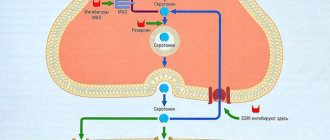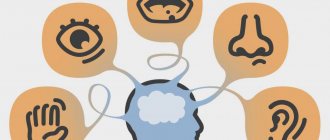This is my hobby: The science of remembering and forgetting
490 rub.0 rub.
Hilde Estby
0 pcs.
This is my hobby: The science of remembering and forgetting
- Hardcover 490 rub.
You are reading an excerpt from the book “This Is My Specialty: The Science of Remembering and Forgetting.”
Alan Baddeley has been studying working memory for 40 years - the discoveries made during this time have made it possible to edit the model of how memories work about what is happening here and now. One of the latest elements added to it is the episodic buffer. It gets its name because it processes our memories and thoughts, recalls them from long-term memory and places them in consciousness.
“Imagine a television screen on which thoughts, memories, images flash. It is a passive monitor that shows a multidimensional picture created by other parts of the brain.”
Alan Baddeley
English psychologist
Behind the scenes, the brain is busy processing the content of what the monitor shows. It is in working memory that we think, solve problems, calculate - and it is also there that memories of our lives are played before our inner eyes. The working memory model helps us understand how and why some things never make it into memory at all. Forgetting in working memory is not the same as forgetting in long-term memory. Working memory is designed to store information for a very short period of time - it is a temporary storage warehouse.
It resembles office mailboxes - company employees take letters from them every day, making room for new ones. Only from these cells the mail will very quickly go into the trash bin if it is not picked up on time.
Content
- Start your day at the same time
- Increase your concentration
- Monitor your sleep quality
- Increase brain endurance
- Improve your problem solving skills
- Get your head in order every day
- Develop mindfulness
- Develop your memory
- The ability to tell
- Make your speech expressive
- What to eat to keep brain cells intact
- Get your brain checked periodically
- Improve your brain's ability to self-control
- Improve your creativity
- Train your willpower
In this article we will talk about how to increase your efficiency and use your brain correctly. Student years are one of the best times for the human brain. After university, the need to train your memory and give your brain complex tasks often disappears. In an idle state, the level of intelligence decreases. To return it to its previous norm, Japanese neuroscientist Takashi Tsukiyama recommends introducing 15 habits into your life.
Start your day at the same time
This habit should not be influenced by external circumstances (got to bed late, didn’t want to get up because of the cold, etc.). Distribute tasks (wash dishes, iron things, sort through bills or distribute files on the computer, etc.): difficult ones - 2 hours after getting up, familiar easy ones - immediately after getting up.
Working with your hands engages the frontal lobes of the brain (choice and decision making).
Talking or reading aloud also helps the brain wake up and improves the perception-processing-reproduction of information.
Since a modern person often gets into a car after quickly getting ready and drives to work, where he sits at a computer all day, his brain is in a sluggish state. It is walking that improves blood supply to all parts of the brain and increases intellectual abilities. To get the maximum benefit, look around and remember the details.
Watering flowers and feeding animals is a great way to calm down and not waste energy suppressing anger and anger.
Increase your concentration
To increase productivity, the brain needs to be warmed up in the morning and “recharged” in the afternoon. Walking and simple exercise helps.
Since vague deadlines for work tasks often lead to procrastination, Tsukiyama recommends setting time limits. When a person quickly copes with a task, this effective state lasts for some time. Do you want to get as much done as possible? Please note that intensive work intervals last only 2 hours and are comparable to an exam.
You can work all day with breaks after 2 hours and end when productivity drops by 30%. When you have a time limit, there is a clear decision, a step-by-step plan and a minimum of options.
Every time you take your work home and devote all your free time to it, high productivity disappears. What does this lead to? A task that took an hour to complete ends up taking the whole day. Distribute the volume of tasks throughout the working hours of the week so that your evenings and weekends are devoted to communication with loved ones and favorite activities.
High productivity requires competition, since the desire to win is inherent in human thinking. A competitive approach helps improve the performance of a company or plant tenfold.
Why do we forget our lives
Forgetting a lot of names and phone numbers is just one aspect of forgetting. The second is that all our impressions slip away like sand through our fingers. What's the point of spending a lot of money on a vacation if you don't remember anything later? But forgetting is our friend, helping us select the main events. Here we are standing and waiting for the bus, going to the store, lying on the couch after lunch - there is no point in storing all these moments in memory. But forgetting affects even the brightest pearls. Only the main elements and the foundation remain in memory - we reconstruct everything else. Our memory is flexible and can reconstruct events.
The largest process of forgetting, covering the largest number of our personal memories, occurs in childhood. Scientists call it childhood amnesia.
For most of us, between the ages of three and five, the boundary marking the beginning of life passes, and we remember it. Some record an earlier period, up to two years, others store very few memories in their memory until the age of seven. And before this line there remains emptiness. We know about the first years of our lives thanks to the stories of loved ones. But where does this forgetting come from? How does a trait appear in memory - and at a certain age? This is a mystery - a riddle that scientists have been struggling with for more than 100 years, probably since humanity began to talk about its own consciousness.
Monitor your sleep quality
It is at this time that the brain replenishes energy resources and processes the information received. In other words, with poor sleep, memory training will be effective by a maximum of 50%, since at night work with thinking occurs more actively than during waking hours.
Before going to bed, it is useful to familiarize yourself with the materials that you will use in your work tomorrow, or memorize a dozen foreign words. Overnight, your brain will process new information, and you will remember it better in the morning.
Preparing for sleep is no less important, since the frontal lobes rest in the evening, and the brain is ruled by emotions. If a person swears, watches horror movies, listens to aggressive music, drinks caffeinated drinks 6-7 hours before bedtime, or thinks about the negative, then he goes to bed in an excited state, which interferes with full recovery. This results in morning fatigue and sluggish work during the day.
Sleep should last at least 6 hours, otherwise, after a few days, disruptions in the nervous system, problems with concentration and confusion in everyday affairs will begin.
Every evening before going to bed, you need to create a calm atmosphere, but without obvious changes. Psychologists and osteopaths advise lying in bed to gradually relax all the muscles - from the toes to the neck.
Ebbinghaus Forgetting Curve
How quickly does the process of forgetting go? This question was answered by the German psychologist G. Hermann Ebbinghaus. At the end of the 19th century, he conducted a series of experiments on his memory, he tested what he remembered from the text at various time intervals. For two years he memorized a meaningless set of syllables, and wrote the results in a notebook. After he collected all the data from his disparate training sessions, he plotted it on a graph that looked something like this. Essentially, it is a simple logarithmic function that describes the disappearance of information from our brain.
The graph shows that when you first learn something, information disappears at an exponential rate, meaning you lose most of it in the first couple of days. After which the level of losses decreases. He simply recorded how quickly we forget. And he found that the rate of forgetting decreases after each repetition. Depending on the cognitive functions of your brain, the Ebbinghaus curve may be shifted slightly. But its essence remains the same.
Newly memorized information is forgotten the fastest; after an hour or two, about half disappears from the head, and after 10 hours – 65%. After a month, we remember only 20% of the information we read. But if you repeat it for an hour, and then a day later, the memory will retain this information much longer.
Later, Peter Wozniak tried to solve this problem by developing the SuperMemo (from Super Memory) memory system.
Increase brain endurance
Good functioning of the frontal lobes is the first thing you need to achieve by training your brain. The frontal lobes act as a checkpoint: they compare new information with what is already stored in memory. As soon as power leaves this part of the brain, a person gives in to emotions, begins to be lazy, simplify and delegate. If this condition drags on, the person loses the ability to make decisions.
Technological progress makes life easier, but at the same time, ready-made meals, robotic vacuum cleaners and parking sensors deprive the brain of basic training. All boring everyday tasks are responsible for the endurance of the brain, which is now especially necessary in order not to develop a nervous breakdown, brain tumor or chronic mental disorder.
In his book, Tsukiyama gives the example of a Japanese businessman-widower from Rolls-Royce, who had the highest sales in Japan, two children and a mountain of daily chores. It was everyday tasks that increased the productivity and endurance of his brain.
If your frontal lobes are not used to giving directions, then when solving large problems you will get bored halfway through. You will not be able to perform difficult tasks and will want to return to the past, where nothing is needed. Increasing brain endurance without self-abuse makes it possible to effectively cope with problems.
Choice, decision and systematization are the work of the frontal lobes, which is possible when preparing dinner or cleaning the apartment.
Improve your problem solving skills
First you need to get rid of unnecessary things and put things in order around you. For internal order in your head, it is recommended to make a list of rules and principles - this helps to set priorities and solve problems when there is a lack of time.
When a person has a plan for the day, the brain works several times more actively, since it is not distracted by extraneous tasks. Living a month with a daily plan, it is easier to analyze mistakes and change your approach. A step-by-step plan is useful for solving any task (from cleaning up seasonal clothes to completing a project or studying a foreign language). You will need a goal, a list of actions and criteria.
A flowchart is structured information that is necessary for the frontal lobes to function properly. It should be taken into account that high regular productivity is impossible if a person solves more than seven tasks at the same time.
Why is it especially important in modern society to improve problem-solving skills? Since most of the day a person acts according to someone else’s instructions (work schedule, tasks from management, transport schedule, navigation in the car and on the Internet). As a result, you can live the whole day without particularly straining your brain and without triggering the work of the frontal lobes.
Get your head in order every day
At university, there are often students who spend much less time preparing for exams. They have the ability to process information faster. This skill needs to be maintained. If you pay attention to the desk of a good manager, there is a minimum of things on it, and there are no unnecessary papers in the drawers. With order on the table, there is no need to make unnecessary movements and at the wrong moment remember where and what is.
Sleep should last at least 6 hours, otherwise, after a few days, disruptions in the nervous system, problems with concentration and confusion in everyday affairs will begin.
Leaky memory: why is it like that?
So, what are the causes of memory impairment?
- Asthenic syndrome (what we call chronic fatigue). Overwork, stress, spring vitamin deficiency - all this can affect your memory and concentration.
- Diseases that cause disturbances in the blood supply to the brain. In particular, these include spasm or atherosclerosis of cerebral vessels, stroke, etc.
- Head injuries.
- Brain tumor.
- Various mental illnesses.
- Alzheimer's disease.
- Alcoholism.
Unfortunately, realizing that remembering something is no longer as easy as it used to be, people rarely go to the doctor. In our culture, there is still a stereotype that says that nothing terrible is happening and a person should pull himself together and not play the fool.
However, the problem is much more complex than it seems. Memory deterioration can be one of the symptoms of a serious illness, and timely contact with a specialist will allow you to effectively combat the disease.
And if asthenic syndrome is the basis for problems with memory and attention, then without the help of a doctor the state of the nervous system will worsen every day, and terrible diseases such as depression, stroke or heart attack may develop.
Develop mindfulness
It is during the non-walking period that pensioners develop dementia more quickly. Since a person needs to receive maximum visual information every day to train the frontal lobes, after work he needs to spend time not with a smartphone, but with a space where there are three-dimensional objects. If you put a person in an empty room with plain walls, then very soon he will begin to go crazy: the intellect needs contact with the visual and tactile world.
TV will not save you, since a person will receive only subjective information without using all channels of perception, and the brain will not function fully. This is why it is useful to walk more often with people who have limited mobility.
Neuroscientists recommend not just looking in front of you, but also to the sides, so that other senses join your vision. Our memory thus stores information about various characteristics of an object. Tsukiyama gives an example of a dog that a person has not yet touched, but already knows how soft its fur is.
This means that the brain does not passively wait for confirmation of information, but goes to it itself.
If you sit in front of a computer all day, then on the street a person may encounter a blurry image, since his brain has become accustomed to a flat screen in 8 hours and now it is difficult for him to switch attention to three-dimensional objects.
During the work or school day, it is important to adapt to a variety of tasks so that some of the brain functions do not go into a sleepy state. A constant routine leads to the fact that a person becomes forgetful, takes a long time to choose words in a dialogue and often falls into a stupor. Such people are slow to read information about their interlocutor and fail negotiations. There is a slowdown in the audience's attention - during a conversation, a person studies the interlocutor for a long time and does not have time to grasp the meaning of the address. As a result, he forgets important dates, the topic of the meeting, assignments, etc.
Enter the habit of doing eye exercises several times a day. For exercises, choose a view from the window and focus in different directions, making sure to use long shots.
Tsukiyama advises his patients to train not only visual perception, but also hearing. Listen to audiobooks and radio programs, and before going to bed, try to remember as much information as possible.
Memory techniques: moving towards practice
Have you noticed that it is quite difficult for you to remember exact dates, sequences of numbers, formulas, the location of objects in the room, the hair color of the person you just talked to? Meet, this is accurate information, and it is precisely this that is the most problematic object when memorizing. We can more easily retell the content of a story or story, and sometimes a novel, but why does our memory work this way?
It's all about the images. When we read a story, we create living images in our heads, endowed with specific features, wrapped in a network of artistic storytelling. We roughly understand what they look like, evaluate their moral component, sympathize with them or, conversely, dislike them. Thus, the concept that is directly related to effective memorization is image. Therefore, mnemonics are mainly tied to this concept.
Another thing that needs to be made clear from the beginning is that there is a mnemonic square rule. This rule consists of the “corners of the square”, i.e. four main points, described below:
- firstly, when creating an image, do not stop at its flat image - be prepared for 3D modeling using your imagination, rotate the object in different directions, notice the details, recreate the most voluminous and realistic image of the object in your head;
- secondly, we add colors, i.e. despite the fact that most of us have an imagination that works in black and white, it is enough just to understand what color we use in our image, and this is a mandatory point - this way we will remember more vividly, and therefore easily;
- thirdly, we remove blurriness, fuzziness, which means that we need to consider as many details as possible, and even if we create an image of an abstract object, we need to transfer it to clarity and specificity mode (for example, if you need an image of the word “hard work”, which has no material expression, replace it with some object that will personify hard work, for example, a plow or shovel);
- fourthly, remember the relativity of sizes and do not allow some images to reach colossal sizes in comparison with others, and here you need to adhere to the basketball rule, i.e. imagine all images - from a fly to an elephant - as a basketball.
So, having become familiar with the main rules for creating images during mnemonics exercises for adults, let’s proceed directly to the rules themselves.
Exercise No. 1. Associative absurd connection
Perhaps the most popular and fun exercise among mnemonics. Its essence lies in the name itself:
- firstly, we are talking about associations, which are the most powerful engine of memory;
- secondly, the adjective “ridiculous” suggests that the associations we come up with must be comic and unreal.
In what situations can this technique be used? In fact, in very many. For example, you have a whole list of places you need to go to, in particular: a baby food store, a friend’s cottage, a pet store, a fitness center, speed reading training, and finally, a home. And how not to get confused in all these matters and forget some place... To do this, you can use the exercise of absurd associations.
Imagine first how a child eats something tasty with a big spoon, but this happens on the veranda of your friend’s very same dacha, then a dog appears, symbolizing a pet store, which suddenly finds itself on a treadmill (association with a fitness center), when suddenly after a run it begins to quickly read the book “The Little Mistress of the Big House”, and the last word of the title of this work will lead you to the final destination among your plans.
It would seem like such an awkward story, but it turns out to be an effective assistant for remembering not only the sequence of actions, but also words in a foreign language, some images, etc. Why is it effective?
The secret of this exercise is that we use the property of absurdity. Human memory is often tuned to remember awkward, clumsy moments (perhaps you remember how you fell or slipped somewhere, or how your friend answered funny at the blackboard by mixing up the sequence of words). Why not use this to create funny images? [AND. Vopilovskaya, 2020]
Consider the following exercise for beginning adults on mnemonics.
Exercise No. 2. Alphanumeric code (BCC)
This technique is widely used in memorizing numerical information. If you are going to present some material and at the same time want to operate with digital data, but you can’t remember all these indicators and the dynamics of their changes, then this exercise is definitely for you.
Its essence is as follows: we encode the series from 0 to 9 using the letters of the Russian alphabet, then we try to create chains of words interconnected by action, we place them in the palaces of the mind and voila - numbers and numbers in memory. If you had difficulty understanding what was described, do not be alarmed - now we will analyze everything in much more detail and with an example.
In fact, there is already a so-called codification of numbers and it looks like this:
- 0 – NM;
- 1 - GZ
- 2- DT;
- 3 – KH;
- 4 – ChShch;
- 5 – PB;
- 6 – ShL;
- 7 – NW;
- 8 – VF;
- 9 – RC.
Why these letters? Most of them are the first letters of the numbers written out, while others are either paired with them or taken due to the use of others. This encoding is considered accepted among mnemonists; it is actively used in the BCC, although you can easily come up with your own, because you will use it yourself. However, the most important thing here is to compose such code and learn it well.
After we have figured out the code, it's time to make words based on a combination of numbers. For example, you have a sequence of numbers 93,876, and this is the number you need to remember. First of all, it needs to be divided into two-digit numbers (93, 87 and 6 remains). After that, we turn to our encoding:
- 93 are the letters P and K - the words “ReKa” are obtained;
- 87 are the letters B and C - it turns out “ALL”;
- 6 is the letter Ш - it turns out to be “Noisy”.
It turns out that the number 93,876 is the sentence “The river is all noisy,” and by isolating the consonants from these words, we can understand what kind of number is hidden.
The only disadvantage of this method is the presence of a pair of letters assigned to a certain number, because when composing words a person can get confused. However, by practicing this method, experienced mnemonists achieve amazing results and successfully implement this method into everyday and official business life.
Please note that when composing images, it is mandatory to include some action - when it is activated, when associated with other objects through action, memory builds stronger neural connections.
We also described above the so-called “mind palaces” (or the Roman room method, the location method, the Cicero method, the memory palace), which means a slightly different memorization of numerical information, built on the basis of a place that you know very well, for example, your room in the house or your garden, etc.
When using this method, the task is to place numbers (or numbers) in specific places in the selected location, for example, the number 23 on a photo frame (because your sister, who is now 23, is there), the number 58 on a chandelier (after all, she is in the shape eight, and you can imagine how the five hung on it), and place the number 9 on the window handle. And so you go into the room, look at the photo, but you can’t see well because the chandelier is not on, and you open the window to let in even more light. This is how we get the number 23,589.
A slightly different application of the BCC exercise is described in the video by Evgeny Buyanov , one of the founders of 4brain:
The BCC method can really help you remember a large number of figures and numbers, which is proven by the example of Joshua Faure, who from an ordinary American journalist and writer became a mnemonics specialist, winning the Memory Championship in 2006 [A. Yastrebtseva, 2013].
Let's move on to the next memorization method.
Exercise No. 3. Sequence Techniques
Everyone knows the phrase “Every hunter wants to know where the pheasant sits,” which we often use when remembering the sequence of the color spectrum of the rainbow. In fact, this phrase is a striking example of mnemonics, but it is far from the only one, and you can create such sequences yourself, also developing your imagination. Other examples here include remembering months with 30 and 31 days using the knuckles, referring to the rhyme about Ivan when listing cases (“Ivan gave birth to a girl, ordered her to drag a diaper”), etc.
Video blogger Egor Sentsov shares some more techniques. In particular, in order to remember the location of the planets of the solar system from the Sun itself in terms of distance, the blogger resorts to a simple phrase that is easy to remember: “We will meet tomorrow, My Young Satellite, at the New Planet!” It is no coincidence that in this phrase each word begins with a capital letter - this makes it easier for us to remember planets encrypted by their first letters, i.e. Mercury, Venus, Earth, Mars, Jupiter, Saturn, Uranus, Neptune, Pluto. The only thing to remember is that Mercury comes first.
Another phrase, which is the key to a more complex sequence of numbers, has the following content: “I’m Masha, I’m a fool, but I’ve found the root of two.” What do you think could be encrypted in this sentence?
In fact, the answer is not so complicated, and is hidden in the phrase itself - it is the root of two. Nevertheless, here we no longer highlight capital letters, but we count the number of letters in each word and it turns out:
Compare the number with the words. It really works! In the same way, Egor suggests remembering the sequence of digits in the number π, but not just with the help of a phrase, but with the help of an additional technique - rhyme. Its essence is similar to the method already described, but in this case we introduce a poetic form, with which it is even more interesting and easier to remember! Take a look:
“I know this and remember it perfectly -
“Pi” many signs are unnecessary for me, in vain” [E. Sentsov, 2017].
this is what we get
And now, you already have 11 decimal places in pi! Share in the comments how you like this method. You may already be using some other memory techniques for adults. Tell us, we will be interested to know what we are missing. And let's move on to the final exercise.
Exercise No. 4. Method of phonetic associations (MPA)
We recommend this exercise for adults who are starting to study mnemonics, especially for those who want to learn foreign languages. The essence of it comes down to three simple steps:
- We translate the word, presenting it in the form of a certain image.
- We say the word again and look for an auditory association (preferably in the language you are learning or in your native language if your vocabulary is still small).
- We connect the two created images from the previous paragraphs.
Well, now is the time for an example. Suppose you need to learn English, and the word boring does not want to be remembered. Then you need to use MFA! The translation of this word is “boring”, and by its sound association the word resembles the name “Boris” or its diminutive interpretation “Borik”. Consequently, we combine the meaning “boring” and the name “Borick” and imagine some guy Boris, who is boring and boring constantly telling something. It will be great if you have a friend Boris and in your head you label him a “boring person”, even if this is not the case. Or you can choose some public figure with the name Boris and also characterize the person in your head.
Many modern online dictionaries in mobile applications offer their own memorization options, in particular, by composing entire sentences, where the main words or parts thereof are highlighted for memorization. Examples include the following:
- generous (generous) - “ husband gave roses to his wife”;
- aunt (aunt) – “Aunt with antennas on her head”;
- laugh (laugh) - “Koa la f snorted and I laughed,” etc.
In addition, some long and compound words can be broken down into parts and also create fun images to remember from simpler words. Let's give examples for this method:
- entrepreneurship (entrepreneurship) - you can imagine that the word consists of something similar to enter (enter) + prenew (pronounced “prenew”), it turns out like “prenew” + ship (ship), respectively, it turns out “enter a prenew ship”;
- hospitable (hospitable) - the word is similar to “hospital”, only at the end there is still the word table (table), accordingly, one can imagine that very rich tables are laid in the hospital, i.e. they welcome you hospitably;
- advertise (advertise) - can also be divided into several words, in particular, first comes the Russian “hell”, then a part similar to “ vert olet”, and at the end almost “ice” (ice); So all that remains is to connect the meanings, for example, if you fly out in a helicopter and fly into hell, then you will urgently need an advertisement for ice, because it is believed that it is very hot there.
Yes, the examples discussed are quite unusual, but very effective. Try this mnemonic technique in your study practice and see for yourself. It is no coincidence that in both examples we gave three parts of speech - nouns, adjectives and verbs - to prove to you that, if desired, any part of speech can be turned into a non-standard image.
We hope that you are interested in mnemonics, and the exercises discussed above will be excellent practice for learning this fascinating, fun, useful and effective technique at the same time.
Develop your memory
Reports, notes, flowcharts - use them to analyze whether you have problems obtaining, structuring and reproducing information.
These exercises help people with the following complaints:
they often forget what they saw or heard; difficult to perceive information by ear; lost in thoughts. Information is quickly forgotten because a person most often does not consciously try to remember it. To prevent this from happening, any important information must be thought through and remembered as if it were a note for another person. Students, for example, are asked to record lectures precisely because this process requires holding the material in their heads for some time.
Interpret new information, turn it into visual images. Tsukiyama conducted a study that showed the following: to improve your speaking skills, you need to speak at least 1000 words a day. You will find more exercises and courses in the sections: memory development in children and memory development in adults.
The ability to tell
Since in the modern world, children and adults transfer most of their communication to instant messengers, the ability to speak beautifully without filler words is given to few people. In order for a child to have clear and rich speech, you need to have daily conversations with him, so that he learns to build a story, and not just answer “yes/no” in monosyllables.
When communicating with friends and family, do not use the topic of work, as people there speak in stereotyped language, using hackneyed phrases.
A useful exercise for memory training: write mini-stories that contain visual images. That is, write to a friend not only the name of the restaurant, but also describe its interior, what color the waiter’s eyes were and what the dish looked like.
Is it possible to forget on purpose
Mnemonist Solomon Shereshevsky memorized meaningless—in fact, endless—series of numbers and words. But even he had one memory-related problem: he was afraid that what he did not forget would interfere with his performance on stage. That is, he was simply afraid of remembering the wrong list of words! The board for recording the words of the spectators was wiped clean each time, but the words were firmly ingrained into the board located in Solomon’s head. He tried many ways to forget them, but the harder he tried, the tighter they clung to his memory.
In the end, he found a solution - he imagined himself folding up a piece of paper with the words he had learned and throwing it in the trash.
It is not known for sure whether this action led to forgetting, but in any case, the list had a special feature that helped distinguish it from the new one when Solomon stood on the stage and the entire auditorium was looking at him. Ironically, he managed to create a guide to forgetting!
Make your speech expressive
Use comparisons and weave details into oral stories. It has been proven that frequent use of comparisons protects against a decrease in the level of intelligence, because complex processes are activated in the brain. Why is this happening? To establish parallels between different phenomena and objects, you need to collect information and consciously process it. Metaphorical speech is observed in people with good memory.
If after a story you often encounter misunderstandings and blame others for this, analyze your story from the outside. This kind of self-reflection is considered an excellent exercise for the frontal lobes.
From stroke to diabetes: why does memory deteriorate?
As you know, human memory is divided into short-term and long-term. Short-term memory (also called primary or active memory) can hold a small amount of information for a short period of time. Let's say, if you need to remember a phone number, your brain uses short-term memory, and within a minute you will safely forget this number. Long-term memory is part of the subconscious and is capable of storing much more information, potentially indefinitely - throughout life.
“Long-term memory is the repository of our knowledge, skills and abilities. Its deterioration can be a consequence of many reasons: from domestic (lack of sleep, lack of nutrition, lack of routine, improper planning of the day, smoking), psychological (stress, depression, neuroses, overwork) to organic, metabolic and degenerative (head injury, dementia, etc. ),” lists neurologist “SM-Clinic”
Yulia Levchenko
.
You should worry about this if memory problems interfere with everyday life, work, and reduce the quality of life. In this case, there is a reason to consult a doctor to determine the cause and prescribe treatment, she advises.
“The fact that we sometimes cannot remember the name of a simple object or a famous actor is not a sign of dementia. And for elderly and senile people, mild memory loss is not a pathology at all. One of the early signs of dementia is a problem with short-term memory rather than long-term memory. This is manifested by increased forgetfulness about current events,” emphasizes Levchenko.
Memory disorder is often a consequence of heart problems, notes Nadezhda Bezemskaya, laboratory diagnostics doctor at the International Network of Independent Clinical Diagnostic Laboratories CITILAB.
Due to a malfunction of the heart (for example, during a stroke), the brain begins to lack oxygen, hence memory problems.
“The cause can be identified using laboratory tests. If there is a suspicion of heart disease, an analysis is carried out to determine the amount of the enzyme creatine phosphokinase in the body (CPK) and its fraction MB (from the English muscle - muscle and brain - brain). The level of CPK and its component CF allows the doctor to judge the root cause of pain in the heart area and the degree of tissue damage, and, as a consequence, the disruption of oxygen supply to the brain,” explains the doctor.
Also, damage to the kidney and liver tissue, diabetes and lack of vitamins can lead to memory impairment.
“If renal and hepatic failure is suspected, hepatic and renal biochemical markers are taken - creatinine, urea AST, ALT, GGTP. Decreased memory can also be caused by the so-called glucose starvation of the brain, this is due to a decrease in glucose levels, especially in diabetes mellitus. In this case, monitoring the level of glucose and glycated hemoglobin helps to identify not only the primary disease, but also to stop the consequences of diabetes,” says Bezemskaya.
Lack of vitamins B12 and folic acid also leads to memory problems. Memory deterioration also occurs with hypothyroidism, which is characterized by insufficient concentrations of thyroid hormones. To exclude or, on the contrary, confirm this disease, first of all, an analysis of thyroid hormones is carried out.
“Memory deterioration and failures are a very complex and multifaceted process of disorders in the human body,” says Nadezhda Bezemskaya. “With this symptom, it is necessary not only to observe and examine, for example, the level of vitamins, but also to look for the root cause under the supervision of a qualified doctor.”
What to eat to keep brain cells intact
Physical activity coupled with healthy food (without overeating) is important not only for the stomach and heart, but also for the brain. Brain diseases are often associated with regular consumption of junk food and excess weight. It leads to a decrease in physical activity and a deterioration in metabolism. Unprocessed fats and sugar slow down brain function because blood pressure rises and the brain does not receive enough energy. The result: blockage of blood vessels, poor capillary circulation, cell death and brain destruction.
To prevent this from happening, you need to include fish, nuts, a large amount of greens and vegetables in your food, and also maintain a food-movement balance. If you don’t want to monitor your calorie intake and expenditure, then follow a simple rule: remain a little hungry after eating.
According to the Aivazovsky method: how to improve memory?
Cicero also said that “memory weakens if it is not exercised.” Therefore, the brain needs training no less than the body. Memory needs to be developed throughout life.
Systematic exercises to train memory and attention can improve cognitive abilities and delay their impairment, says Yulia Levchenko.
Various techniques are used for this:
- memorizing texts, songs, poems;
- solving crosswords, logical puzzles;
- associative memory games;
- Aivazovsky’s method (you need to look at an object for five minutes, and then, closing your eyes, restore it in memory or in a drawing);
- Cicero’s method (what needs to be remembered is located in a well-known place, for example, in a room; when “passing” the room, the necessary information pops up);
- Exercises based on Schulte and Bourdon tables.
“Also, to improve memory and prevent memory impairment, lifestyle modification is important: good nutrition, healthy sleep, quitting smoking, physical activity,” recalls the neurologist.
Improve your brain's ability to self-control
Analyze your mistakes to understand what brain capabilities you are using inappropriately or not to their full potential. Psychologists recommend keeping a diary of successes and gratitude, and Tsukiyama recommends adding a diary of failures to them.
Most often, minor failures are repeated regularly (for example, constantly spilling water, dropping dishes, crashing into door frames, forgetting things). To avoid major mistakes, you need to analyze why this is happening to you, to understand where the problems with coordination or other functions come from. Tsukiyama notes that small everyday mistakes happen at the same time. This is due to the biorhythms of the brain.
Train your willpower
Will slows down and accelerates a person. It is important that the desired goal is strong, otherwise the person will be blown away at the first difficulties. When learning and in your personal development, it is recommended to give feedback in the form of praise or constructive criticism. A great way to improve brain function is to look for things to praise the other person for, which will help you become more attentive.
At the beginning of the article, we already mentioned that live communication is necessary for the balance of brain functions. If we talk about dating, they have a positive effect on the functioning of the brain. A change of environment, new people - everything makes the brain work a little more actively.
15 habits from neuroscientist Tasaki Tsukiyama are challenging self-work that you can do this year and change your life for the better.










